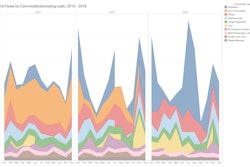
2015 is likely to be remembered—not necessarily fondly—for challenging and volatile commodities markets. Only a couple of months in and it looks as though 2016 may not be much different. Many commodity-intensive corporates are re-thinking their approach to treasury, procurement and risk as a result. In the more predictable markets of the past, many found it possible to manage these functions with a little spreadsheet wizardry. But that method is proving inadequate to navigate today’s choppy waters.
It is estimated that a sizable majority of companies with large commodity exposure do not have an integrated system that allows them to manage commodity procurement along with treasury and risk. Rather than tailor-made commodity procurement risk management (CPRM) systems, these businesses have home-grown solutions, multiple—in some cases thousands of—spreadsheets, or an outdated legacy database. None of these approaches in isolation is up to the job. With these limitations, nobody could ever be expected to gain a clear perspective of a company’s entire risk, cash and procurement picture.
What’s interesting is how commodity-intensive industries could learn a lot from the evolution of energy trading over the last couple of decades. Only 20 years ago, energy trading was a relatively simple physical business in which participants could manage their hedging on spreadsheets. But after Enron imploded and the major banks piled on added volatility, the industry emerged more sophisticated in a short amount of time. The banks introduced complexity around their basic management, risk and accounting systems, as well as other factors, such as derivatives and exotic hedging strategies—all of which created an alphabet soup of checks and balances that make it hard to manage from a singular place.
Many commodity-intensive corporates today face the same level of complexity. The response from some forward-thinking firms is to move towards total margin management (TMM), which allows corporate treasurers to streamline and integrate their most important functions.
As a result, they can manage and monitor margin creation (and destruction) from each and every part of the commodity value chain, and manage all processes into one singular, real-time platform. A company’s spending, the state of its treasury and its risk exposure are all related, and must be kept in mind for all accounting reporting. The CFO doesn’t want any surprises. So why should they all run on different systems? Not only does it benefit a company’s bottom line, but a unified system can also provide global visibility into cash and step-by-step accounting for compliance officers in a way that an Excel file simply can’t.
It isn’t only about protecting margins and managing risk (though this is important). It has implications for mergers and acquisitions (M&A), too. A company that doesn’t know its true commodity exposure does a great disservice to shareholders. Given trends within the M&A space, TMM can be a big help pre- and post-acquisition.
The danger is that, without a clear, sophisticated and comprehensive approach to commodity exposure, companies can appear undervalued. A company needs clear visibility into the raw materials it uses so it can hedge against that spend for a management plan. For example, food and beverage companies purchase large amounts of raw materials and look forward to hedge their purchase price. As unhedged raw materials can create unexpected hits to a company’s profits, any incremental savings they can eke out of the supply chain gives them an edge. And it can be particularly detrimental if, during an unexpected acquisition, a company is stripped away of its incremental budgeting—when instead of justifying only variances compared to past years, it is asked to start over.
This is called zero-based budgeting and is an approach deployed today by companies such as 3G Capital, the Brazilian-based company that applied this as standard during its recent M&A spree—buying Anheuser-Busch to merge with Inbev, then moving on to buy Heinz to merge with Kraft. If these companies already put in place a total margin management approach, they would have looked far more attractive.
Example:
- A large food and beverage company has $462M of raw materials on its $23B balance sheet. Its stock price is $54 with 612M shares and a market cap of $33B. In Q1 2015, the mark to market valuation for those materials drops $49M.
- This would have a significant effect on its shares, with annualized earnings per share (EPS) dropping from $2.30 to $2.25, putting approximately $750M of market cap at risk.
With zero-based budgeting and measuring from the ground up, there isn’t room for a homegrown system to manage the commodity procurement process. One company (or even each company department) may be hedge sourcing—one may have a treasury management system, and another may have its own way of managing commodities procurement, and a different system for currency, debt and investment management. Any one of these companies could have been using as many as five vendors (with all the unnecessary cost this entails). Companies need an integrated approach to eliminate separate processes that may be rife with inaccuracies.
The Nirvana of any organization with commodity exposure is to put all debt management, commodity management and risk management on a single platform with full transparency. Nirvana is of course tough to reach, but there’s progress, and total margin management is an important step in the evolution of management for commodity-intensive corporates.
Mark O’Toole is the vice president of commodities and treasury solutions at OpenLink.



















